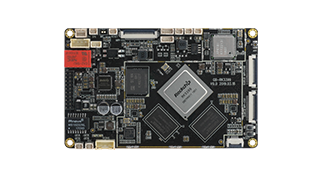ADC 使用¶
简介¶
Face-RK3399 开发板上的 AD 接口有两种,分别为:温度传感器 (Temperature Sensor)、逐次逼近ADC (Successive Approximation Register)。其中:
TS-ADC(Temperature Sensor):支持两通道,时钟频率必须低于800KHZ
SAR-ADC(Successive Approximation Register):支持六通道单端10位的SAR-ADC,时钟频率必须小于13MHZ。
内核采用工业 I/O 子系统来控制 ADC,该子系统主要为 AD 转换或者 DA 转换的传感器设计。
Face-RK3399 只提供一路外接的ADC(ADC_IN3)给客户使用。
下面以SAR-ADC使用ADC风扇为例子,介绍 ADC 的基本配置方法。
DTS配置¶
配置DTS节点¶
Face-RK3399 SAR-ADC 的 DTS 节点在 kernel/arch/arm64/boot/dts/rockchip/rk3399.dtsi 文件中定义,如下所示:
saradc: saradc@ff100000 {
compatible = "rockchip,rk3399-saradc";
reg = <0x0 0xff100000 0x0 0x100>;
interrupts = <GIC_SPI 62 IRQ_TYPE_LEVEL_HIGH 0>;
#io-channel-cells = <1>;
clocks = <&cru SCLK_SARADC>, <&cru PCLK_SARADC>;
clock-names = "saradc", "apb_pclk";
status = "disabled";
};
用户首先需在DTS文件中添加ADC的资源描述:
kernel/arch/arm64/boot/dts/rockchip/rk3399-firefly-demo.dtsi :
adc_demo: adc_demo{
status = "disabled";
compatible = "firefly,rk3399-adc";
io-channels = <&saradc 0>;
};
在驱动文件中匹配 DTS 节点¶
用户驱动可参考Firefly adc demo :kernel/drivers/iio/adc/adc-firefly-demo.c,这是一个侦测Face-RK3399风扇状态的驱动。首先在驱动文件中定义 of_device_id 结构体数组:
static const struct of_device_id firefly_adc_match[] = {
{ .compatible = "firefly,rk3399-adc" },
{},
};
然后将该结构体数组填充到要使用 ADC 的 platform_driver 中:
static struct platform_driver firefly_adc_driver = {
.probe = firefly_adc_probe,
.remove = firefly_adc_remove,
.driver = {
.name = "firefly_adc",
.owner = THIS_MODULE,
.of_match_table = firefly_adc_match,
},
};
接着在firefly_adc_probe中对DTS所添加的资源进行解析:
static int firefly_adc_probe(struct platform_device *pdev)
{
printk("firefly_adc_probe!\n");
chan = iio_channel_get(&(pdev->dev), NULL);
if (IS_ERR(chan)){
chan = NULL;
printk("%s() have not set adc chan\n", __FUNCTION__);
return -1;
}
fan_insert = false;
if (chan) {
INIT_DELAYED_WORK(&adc_poll_work, firefly_demo_adc_poll);
schedule_delayed_work(&adc_poll_work,1000);
}
return 0;
}
驱动说明¶
获取 AD 通道¶
struct iio_channel *chan; //定义 IIO 通道结构体
chan = iio_channel_get(&pdev->dev, NULL); //获取 IIO 通道结构体
注:iio_channel_get 通过 probe 函数传进来的参数 pdev 获取 IIO 通道结构体,probe 函数如下:
static int XXX_probe(struct platform_device *pdev);
读取 AD 采集到的原始数据¶
int val,ret;
ret = iio_read_channel_raw(chan, &val);
调用 iio_read_channel_raw 函数读取 AD 采集的原始数据并存入 val 中。
计算采集到的电压¶
使用标准电压将 AD 转换的值转换为用户所需要的电压值。其计算公式如下:
Vref / (2^n-1) = Vresult / raw
注:
Vref 为标准电压
n 为 AD 转换的位数
Vresult 为用户所需要的采集电压
raw 为 AD 采集的原始数据
例如,标准电压为 1.8V,AD 采集位数为 10 位,AD 采集到的原始数据为 568,则:
Vresult = (1800mv * 568) / 1023;
接口说明¶
struct iio_channel *iio_channel_get(struct device *dev, const char *consumer_channel);
功能:获取 iio 通道描述
参数:
dev: 使用该通道的设备描述指针
consumer_channel: 该设备所使用的 IIO 通道描述指针
void iio_channel_release(struct iio_channel *chan);
功能:释放 iio_channel_get 函数获取到的通道
参数:
chan:要被释放的通道描述指针
int iio_read_channel_raw(struct iio_channel *chan, int *val);
功能:读取 chan 通道 AD 采集的原始数据。
参数:
chan:要读取的采集通道指针
val:存放读取结果的指针
调试方法¶
Demo程序使用¶
在kernel/arch/arm64/boot/dts/rockchip/rk3399-firefly-demo.dtsi中使能adc_demo,将”disabled” 改为 “okay”:
adc_demo: adc_demo{
status = "okay";
compatible = "firefly,rk3399-adc";
io-channels = <&saradc 0>;
};
编译内核,烧录内核到Face-RK3399 开发板上,然后插拔风扇时,会打印内核log信息如下:
[ 85.158104] Fan insert! raw= 135 Voltage= 237mV
[ 88.422124] Fan out! raw= 709 Voltage=1247mV
